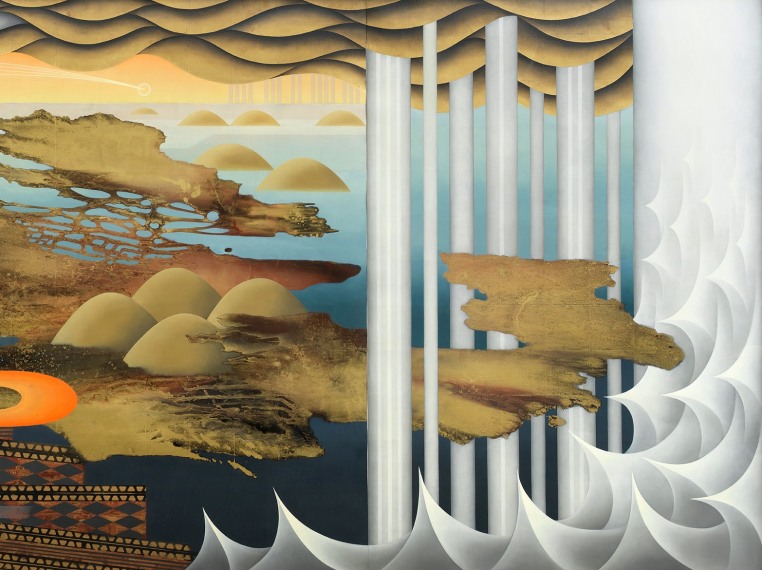
Ortuzar Projects is pleased to present a selection of works by Los Angeles–based artist Takako Yamaguchi (b. 1952, Okayama, Japan) for Frieze New York 2023, which is concurrent to the artist’s exhibition of new paintings at the gallery. The five selected paintings, which range from 1990 to 2021, capture the artist’s committed exploration of genre and their cultural frameworks through her combination of parallel art histories as eclectic as Japanese decorative arts, Mexican muralism, Photorealism, and Art Nouveau. Yamaguchi has long been sensitive to the tension between an ostensibly race-neutral kind of International Modernism on the one hand, and the aesthetics of local, national, and ethnic identity, on the other. Rejecting the formal reductivism of Euro-American abstraction as a simplification of difference, Yamaguchi has turned instead to what she has dubbed, “the trash-heap of discarded ideals.” Looking at artistic movements that are unfashionable or that have fallen out of favor, Yamaguchi focuses her attention on such disfavored subjects as decoration, fashion and beauty, sentimentality, empathy and pleasure—a collection of forms and values she holds all the more dear for the ease with which they were displaced by modernity.
The earliest presented work, Small Radial Symmetry (1990), features a female figure merging with the earth in a style derived from Diego Rivera. Interested in the rise of identitarian politics within the art world, Yamaguchi’s appropriation subverted expectations of her as a Japanese-American painter, playing instead with her adopted identity as a Southern Californian. Yamaguchi developed her uniquely syncretic approach to art making well before the term “globalism” became commonplace, combining varying artistic styles “to challenge received notions of ethnic identity and the presumed ownership of culture.” In Victoria & Whiskey (1995), she leans into the visual pleasures of Art Nouveau ornamentation, which against the height of the culture wars of the nineties was demonized as too feminine, fickle, or superficial. Continuing her engagement with the female figure throughout art history, Yamaguchi paints in a distinctively flat, illustrative manner; the two-dimensionality of the work underscored by the textural patterns evocative of a Japanese screen and the pose of a fashion editorial.
The monumental oil and bronze on paper, Found, Lost and Then Found Again (2004), is an elaborate seascape that destabilizes conventions of both European and Japanese painting traditions. Beginning with an aleatoric spill of metallic paint, the artist then wrestles the abstraction into submission by superimposing entangled ocean, cloud, and landscape motifs, themselves set into tension with geometric patterns alternating between crisp, bright colors and reflective bronze leaf. Through contrasting the sublime sensibility of 19th-century European Romanticism and Japanese craft, Yamaguchi creates a “dialectic of order and chaos” that straddles two aesthetic frameworks historically at odds.
A stylistic departure, Untitled #2 (black and pink) (2009-2021) belongs to a series of hyperrealist paintings based on photographs of female nudes, referencing or sometimes directly copying American modernist photographers like Edward Weston and Alfred Steiglitz. Connected conceptually to previous series through her engagement with both a genre and subject matter that felt disregarded by the art world mainstream in the late 2000s, the work's meticulous rendering of flesh is undermined through its obfuscation by a bright pink plexiglass frame. Frustrating any attempts to admire the work’s craftsmanship, the framing pushes the painting into fetish object, and the viewer in a place from which they can look but not touch. This emphasis on materiality, visuality, and display is continued in the artist’s white-on-white paintings, a series of trompe l’oeil renderings of shallow white bas-relief constructions that slyly problematize the familiar distinctions between abstraction and representation.
Takako Yamaguchi received a BA from Bates College in Lewiston, Maine in 1975 and a MFA from the University of California, Santa Barbara in 1978. She has held recent solo exhibitions at as-is.la, Los Angeles (2022); Ramiken Crucible, New York (2021); Egan and Rosen, New York (2021); STARS Gallery, Los Angeles (2021); Cardwell Jimmerson Contemporary Art, Los Angeles (2010); Nevada Museum, Reno (2007); Kathryn Markel Fine Arts, New York (2007); and Jan Baum Gallery, Los Angeles (2006). She has been included in institutional surveys including The Ocean, Bergen Kunsthall, Norway (2021); With Pleasure: Pattern and Decoration in American Art 1972-1985, Museum of Contemporary Art, Los Angeles and Hessel Museum of Art, Center for Curatorial Studies at Bard College, Annandale-on-Hudson, New York (2019-2021); Transcendence: Abstraction & Symbolism in the American West, Nora Eccles Harrison Museum of Art, Logan, Utah (2015); California Echoes: Women Inspired by Nature, Orange County Center for Contemporary Art, California (2007); and L.A. Post-Cool, Museum of Art, San Jose, California (2002). Her work is in the collections of Nevada Museum, Reno; Nora Eccles Harrison Museum of Art; Long Beach Museum of Art, California; the Lynda and Stuart Resnick Collection, Los Angeles; and Deutsche Bank, New York, among others.
